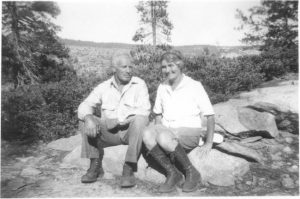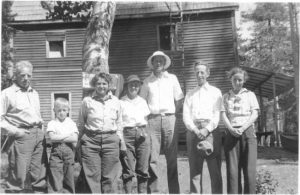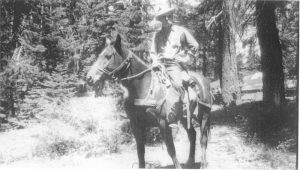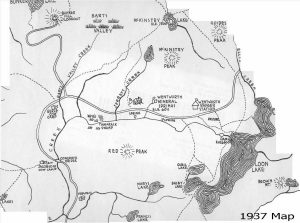Wikander Cabin Buck Island Lake California

In the words of Judge Wilbur Johnson………..“Picture 6 Vic Wikander and his wife, Alice.
“Victor Hugo Wikander
Victor was born in Finland of a Finnish father and an Irish mother in June 9, 1881. He immigrated to the United States in 1902. He was naturalized a citizen in 1909. His early occupation was as a civil engineer. At some point he became a snow cruiser in the Georgetown Divide area and became acquainted with Rubicon Springs, Rockbound Lake, Buck Island Lake, Loon Lake and Wentworth Springs.
At a time before 1920 he became acquainted with a young school teacher at Oakland High School, Oakland, CA. They married and honeymooned at Rubicon Springs in one of the small cabins adjacent to the Inn and available for rent in those days. Victor’s wife was known as Alice, however the 1920 census records give her name as Cecila. Her middle initial is given as “B” at one point and as “A” at another. I suspect the “A” is correct, indicating the origin of her being known as Alice.
While honeymooning they visited Buck Island, over the hill from Rubicon to the west. Victor worked out a 99 year lease of the smaller island at Buck Island, I presume with the U S Dept. of the Interior.
In the 1920’s Rubicon Springs continued to be accessible by motor car and Victor began to take in the materials needed to improve the leased island. He carried everything over the hill to Buck Island by back pack, a little over a mile but up quite a grade. (NB: The last motor vehicle into Rubicon (until the Jeep) was a Cadillac touring car operated by an enterprising fellow from The Lake (Tahoe). On the way out the Caddy slid off the road at one of the switchbacks and was abandoned. This occurred around 1928-1930 and the vehicle remained, somewhat intact, for quite a few years. From this, the current name, “Cadillac Hill”, was coined.)
As time passed, Victor built a rowboat, first of all, and then 3 cabins. A main cabin and 2 smaller cabins as guest houses. He flew 3 flags; The Stars and Stripes at the main cabin and the flags of Finland and Ireland at the guest cabins.
He laid out paths cabin to cabin and other points of interest on the island. He gathered stones, 4 – 6 inches in diameter. and lined the paths. Using the rowboat, he gathered sand from the far west side of the lake and sanded the paths.
He also built a catch-all storage shed near the main cabin and a boat house with skids to house the rowboat over the winters. Sometime, during later years, he stopped using the boat house. He just pulled the boat out of the water and left it in the open. One time, I asked, “Why?” He said that, in the boat house, the boat dried and seeped leakage by the next season.
He spent all summer every year at the island. His wife joined him when school was out. He also went in regularly in winter. His wife never joined him on the winter trek. He put a door high in the gable of the main cabin to avoid digging snow down to the front door. Each summer season he would provision the cabin for the winter trek, food and fuel. One year he fell and broke a bone in the ankle area, possibly the lower end of the fibula. He crawled into the cabin and set the break as best as possible and bound it with strips of cloth. He spent the next few weeks holed up in the cabin waiting for the break to knit. What a guy!
His island was close to the north shore of Buck Island Lake, about 50 yards or so. The water there was shallow and in winter it froze enough for him to ski/snow shoe across. In the spring he could wade . At most, the water depth was about 5 feet at one point. Thus, he never really had to “swim” to the island.
He spent many idyllic years at the lake until the 1950’s when age began to take its toll. He passed away in Oakland, Alameda Co. CA, on August 7, 1958. His wife, Alice, survived another few years until the early 1960’s. End of an era! (no children).”
In the words of Judge Wilbur Johnson……Jeeps and Buck Island Lake…….
“Sometime in 1948, I spent the summer taking at least 4 trips into the Divide. I was shortly home from service in the Far East with Uncle Sam and decided to spend the Spring, Summer and part of the Fall in my favorite stomping grounds. From all of this come great memories!
THE FIRST JEEP!!!
In 1948, I was with Vic Wikander at Buck Island; just the 2 of us! Unusual but true. We were enjoying a peaceful week, or so, and an incident happened that is forever imprinted. A JEEP came by. We heard the noise and stepped out to see what was going on. A lone Jeep with no more than a driver had managed to come eastward and got to the lake (Buck Island). We watched in wonder as this “crazy guy” passed on toward Rubicon. I assume that the he made it out OK. (No person today, does the trip alone, I’m led to believe.
My reaction was “there goes the neighborhood!”. Interestingly enough, Vic was not disturbed. I thought it was an invasion into our peaceful back county. I was prescient; 250 or more Jeeps go through these days. The solitude is no more!
To add to the trauma, mine, I encountered another Jeeper coming the the other way (Westward) on the following day. I had walked down toward the Rubicon and came upon a Jeeper stalled in the sluice box out of the Rubicon. I actually helped this “nut” get some traction, moving rocks, boulders, etc. He continued on and was never seen again.
Victor, later that summer, told me he had laid out out a path on the granite to by-pass the sluice box from the West down to Buck Island. I was crushed! I guess that by then Vic had spent so many years in there that company, of whatever ilk, was welcome.
4-5 years later the Jamboree came into being. Downtown Manhattan had come to Valhalla. A “slain warrior” to this day! (Look it up in your Funk and Wagnalls. (Valhalla, that is!)”
More from the Judge Johnson on Vic Wilkander and events at Buck Island lake……in his words……
In the late 40’s I spent a week with Vic Wikander at Buck Island, just the 2 of us.
Vic mentioned that he was seeing non native fish and certainly nothing planted by Fish and Game. He identified them as sucker fish. At first glance, while in the water, they look rather pretty. Once out, they are ugly with a turned-down mouth that looks like a sucker. Ugh.
We decided that someone, sometime had fished Buck Island with live bait and dumped the bucket. God only knows when!
Vic and I rowed around the shore and came upon a spring rivulet coming down into the west end of the lake. We observed suckers running up the stream like salmon. There were hundreds! Going to spawn!
We mounted the rise and found that the stream could be diverted.
We returned to the island and fastened about 6-7 feet of chicken wire, that Vic, for some reason had, to two 6 foot stakes with sharpened ends. We went back to the stream and noted that the last 80-100 yards were rather level and that the fish seemed to be gathering in the slower water to lay their eggs.
We lay back for a day or so watching, every few hours, the fish activity and when it looked as though the migration was less, we placed the wire screen across the stream, a few yards from the lake proper, and drove the stakes in so that the wire mesh created a complete obstacle to any fish, in or out.
We then went up the slope and with sand, gravel, dirt, etc., blocked the flow of water over to an adjacent path, thus stranding the hundreds of suckers in a fast reducing water supply.
We were armed with a rake and a shovel. When the flow was virtually stopped we started raking and shoveling the ugly things out of the little creek bed. We piled them far enough from the stream that they could not flop back in. We left until the next day. Not a dead fish in sight! They were eaten overnight by the wildlife.
I cannot believe that we eradicated the suckers, but what the heck, the lake is now just a reservoir, as are Fox, Rockbound and Loon. The virgin days are gone forever!
I recently came across this local Georgetown-Placerville Liddicoat Family history showing their early involvement with using Jeeps on the road from Georgetown to Lake Tahoe via Wentworth Springs and Rubicon Springs with wonderful pictures of Wentworth Springs in 1946 along with detailed pictures of their Jeep travel on the road including historic pictures of Rubicon Springs and the bridge before the steel bridge and after……….This website is a must review for a look back 60 years plus at Rubicon Springs and road to Lake Tahoe. So the Judge and Vic Wikander missed a few of the early local folks who put Jeeps across the road………..
Picture 6…Wentworth Springs…..30’s family and friends in group photos…in the words of Judge Wilbur Johnson…..“Vic is to the left and Alice Wikander is the lady in the middle”.………More names on this photo to come….

Picture 7…Wentworth Springs….in the words of Judge Wilbur Johnson……….
“The persons shown in the photo of whom you inquire are, from the left”
Victor Wikander (vital stats in the mail)
Superior Court Judge Wilbur Johnson,
Wife of the tall man in topee, first name Don. (the man I mean) I do not remember their last name. I do remember that they were not perennial visitors to the Springs.
Alice Wikander. You have her real name in the mail enroute.
Don ???
My paternal grandfather, Wilbur Marshall Johnson (another jack of all trades0
My mother, Ada Larue Johnson, nee Green.
This photo dates from around 1935.”
Wentworth Springs US Forest Service Ranger Station….East of Wentworth Springs on the Georgetown-Lake Tahoe Road at the Wentworth Springs Forest Service Campground……..
In the words of Judge Wilbur Johnson on the Ranger Station at Wentworth Springs……..
“Mike, I cannot wait! It is late but I am not sleepy so I’ll spin a yarn about the Ranger Station at the Government camp ground above Wentworth Springs.
The station was a rather small cabin; room for a wood stove and a bed. It was only manned when the Ranger from G Town went up to check on the camp ground, etc. It was the eastern end of the Forest Service telephone line. The phone was the old hand crank type, magneto, with a one wire transmission. (phantom circuit?)
About 1939, or so, I was with Rob Jerrett when he used it to call G Town Ranger Station for some reason.
Now that I think of it, there was no phone at the main building at the Springs. I do not know where the wire was at that location. I’m sure it must have had Bunker Hill lookout on the line; maybe the line was further to the north at the Springs, up on the hill to the north.
That’s about all I can say about the Ranger Station at Wentworth Camp Ground. I do know that it was there. I saw it!!!”
Rubicon Springs Bridge Replacement…….in the words of Judge Wilbur Johnson………….a great story as well…………..
“One incident I cannot leave to later. I said in Chap. 1 that the Cadillac of hill fame was the last until the jeep. I mis-spoke! Sometime in the early 1940’s the U S Forest Service decided that the bridge over the Rubicon, just up-stream from the springs should be replaced. The old bridge was wooden and had weathered many tough winters.
Anyway, I was wandering around in the valley, downstream from the springs, and came upon a Model T flat-bed truck, loaded with a great pile of duffel aboard. The Model T was manned by 4 of the largest characters I had even seen. A father and 3 sons; I believe that their name was Farmer. They were out of either Placerville or Auburn, I cannot remember which.
They were stopped at a ditch about 4-5 feet deep and about 8 feet rim to rim. I asked, “How are you going to get across that?” The father said, “Watch!”
They unloaded the duffel and carried the bags, boxes, etc., to the far side.
The 4 then proceeded to PICK UP the Model T and carry it across the obstacle.
Wow!
They re-loaded and continued on. I do not remember seeing them again. I think that they went back out and carried in the makings of the steel girder bridge that may exist to this day.
The point here is that a Model T preceded the Jeep!! I asked if they had a
Ruckel Transmission. The dad said you are too young to know such things but yes they had such a transmission in the truck. The transmission, if spelled correctly, gave the Model T a low gear similar to the Jeep of years later.
It was not as agile as a jeep for it was, yet, a 2 wheel drive. But, by golly, it came in and went out of the Rubicon!”
Sheep Herding and a wandering young boy…..Wentworth Springs Campground and to the East….another wonderful story of the times……..
In the words of Judge Wilbur Johnson…………
“I know very well why Rob Jerrett used the old crank phone. It was because of me and my mother.
Earlier, in the day of the phone call, a flock of sheep were herded through the Springs campground, about a mile, or less, from the Ranger Station.
I took off with the flock having a wonderful time herding sheep. I did so about 2 miles east. The sheepherders were amused at my interest and zeal. They tolerated my joining in.
After about 2 miles I broke off and started back to The Springs. I encountered Rob Jerrett at the Ranger Station. He took one look at me and said (expletive deleted) get in the truck. He then went to the Forest Service phone and called in a “cancel search” message. My mother, Ada, had hit the panic button. She was convinced that I had been kidnapped by the sheep herders. (they were noted in legend to carry off little boys)
Jerrett thought the incident was funny. Ada, to the contrary chewed me out for taking off with no advance warning. I was quite contrite, but still think it was a great adventure.
I have often wondered where they were taking the sheep. I suspect they were headed for the meadows upstream from Rubicon Springs where there was plenty of new grass for the sheep.
Another fond memory!”
Judge Wilbur Johnson Retired……1945
In the words of Judge Wilbur Johnson……”One year later, 1945, just before I enlisted in the U.S. Army. Funk met me just east of Miller Lake and I took the two pack horses in by myself. My God, what a kid won’t do. If my horse had spooked or stumbled on the steep trail I would be bleached bones along the trail. My dad is not in the picture for he is loading the al forjas bags. We had fashioned our gear to “pack”. We made thin plywood boxes just the size to slip into the al forjas bags. We packed the boxes full and when ready just lifted them into the bags. We also made a stove out of sheet metal. About 3-4 feet long, 16 in. wide and about 10 in. high. A hinged door on the front. A 4 in. stove pipe hole in the top rear. 2 sections of stove pipe fit inside the stove for transporting. Also there was room for a trenching shovel and an axe. I almost forgot, there was room for 4 angle iron legs for the stove. The stove had 1/4-20 bolts with wing nuts to fasten the legs. My mother cooked some darned good meals on that stove. Pancakes were cooked of the surface, no pan needed.”




